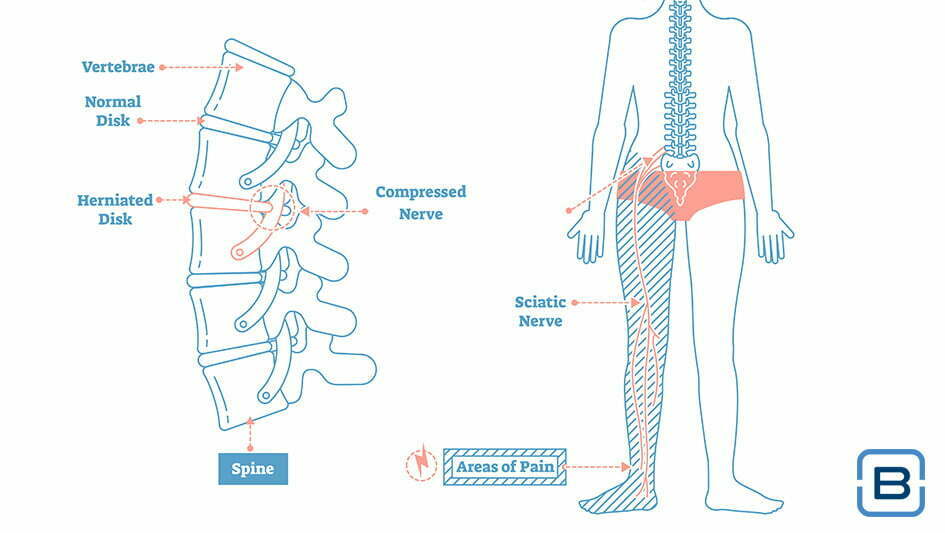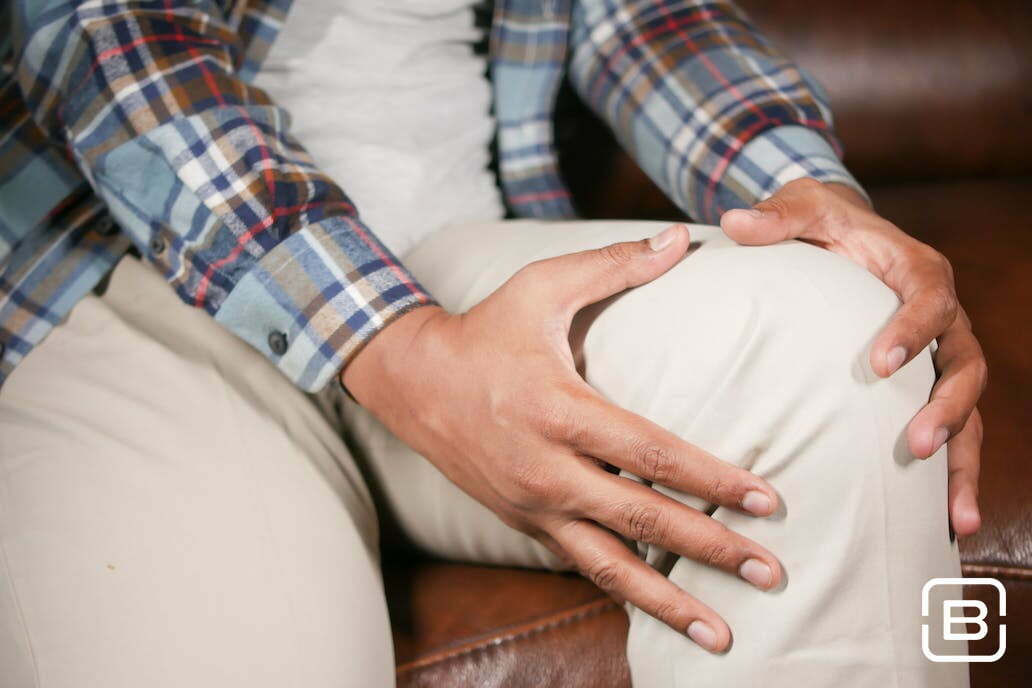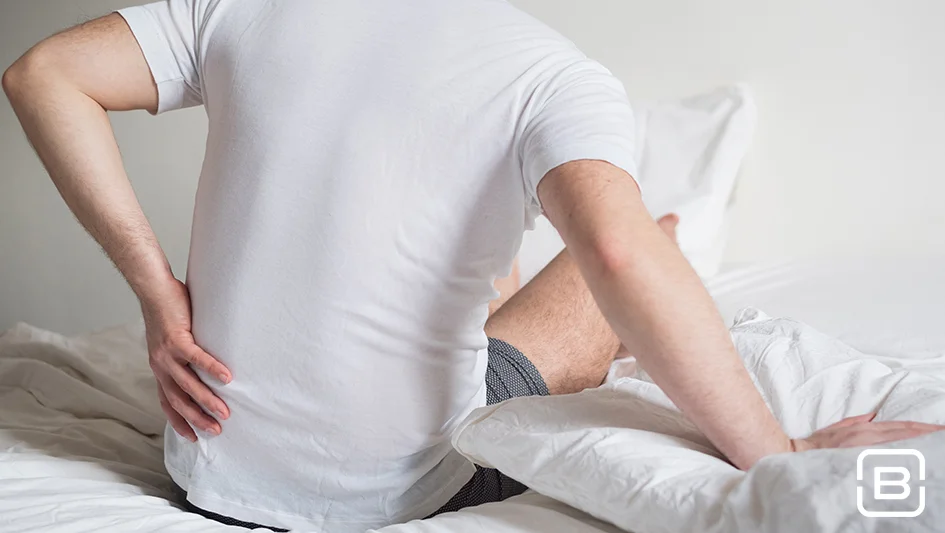Sciatica is a condition that describes a shooting pain down one leg. The pain can be felt in the buttock, lower back, and on the inside or outside of the leg. Rarely the pain can affect both sides of the body but usually only one side is affected. Sciatica is a common condition with around 40% of the UK population likely to experience it during their lifetime. If you’ve been wondering “what causes sciatica to flare up?” then read on for causes, symptoms and tips to get immediate relief for sciatica pain at home.
The sciatic nerve is the largest nerve in the human body. It runs all the way from the sacrum within the pelvic area, down through the thigh until it splits just above the knee into the tibial nerve and the common fibular nerve, which travel all the way to the foot.
If the sciatic nerve becomes damaged, irritated, inflamed or compressed, this can cause sciatica to occur. The most common ways the sciatic nerve becomes compressed is through conditions that affect the lower back, injury, trauma, or overuse. There are different lifestyle and risk factors that can cause sciatica to flare up.
Sciatica flare ups are caused by compression of the sciatic nerve. If you have a condition that affects your lower back, such as a herniated disc, this can put pressure on the nerve and cause pain symptoms to appear. Other lifestyle-related risk factors include age, lack of exercise, or recent surgery.
Sciatica flare ups can be caused by:
- Injury, such as a hard fall
- Physical sports and weight lifting
- Overuse, such as from a physical occupation
- Pregnancy
- Endometriosis
- Muscular hypertension
- Hip replacement surgery
Age is a risk factor in either developing sciatica for the first time or in contributing to lower back conditions that can cause flare-ups. Sciatica can affect people as young as in their 20’s, but people between the ages of 40 and 59 are most likely to experience sciatica. Men are up to three times more likely to develop sciatica, although the condition can affect both men and women.
Lack of exercise and long periods of inactivity are a risk factor for sciatica. Exercise can help condition the body, improve flexibility, blood flow and increase muscle strength. Exercise is often prescribed to improve chronic sciatica, and promoting good physical condition throughout your life can make it less likely you will develop the condition.
Those who exercise less are more likely to be overweight, and this additional weight can put pressure on the nerve that causes sciatica. Those who lead very sedentary or inactive lifestyles may suffer from a deconditioning of the muscles that support the back, which can worsen any strain or trauma of the spine and its surrounding structures.
You are more at risk for developing sciatica if you suffer from:
- Spinal disc herniation (slipped disc)
- Spinal stenosis
- Piriformis syndrome
- Spondyolidtesis (misalignment of vertebrae)
Other lifestyle factors can cause sciatica to flare up. Footwear that doesn’t properly support your legs and spine can trigger sciatica pain or make it worse. Wearing high heels, especially for long periods of time, can cause you to shift your weight forward, placing strain on the lower back and promoting sciatica pain. Flat footwear that comfortably supports your back is less likely to cause a sciatica flare up.
Sciatica may feel worse if you experience a jolt, for example if you sneeze or cough. Some people find that movement makes their pain worse, while other find that movement and light exercise improves their symptoms.
What does sciatica feel like?
People describe sciatica as a pain that affects one side of their body. It can be a shooting pain that travels from the buttock to the leg and the foot. Other people describe the pain as an ache, tingling, or burning sensation.
Sciatica can cause parts of the body to feel numb, tingly or weak. In some cases, this weakness is enough to effect movement and function. People sometimes feel that it is harder to lift their foot or move their toes (foot drop).
How long does sciatica pain last?
Sciatica usually gets better within a few weeks. After 4 to 6 weeks most people will see an improvement or stop experiencing sciatica pain. However, pain can recur, especially if the underlying causes of sciatica go untreated.
If you experience pain that lasts for a long time, it is important to get your symptoms checked out and seek the advice of a GP or a specialist who can assess your condition thoroughly.
Why sciatica comes and goes is up to the physical condition and lifestyle of the individual. While some people may only experience one or two flare ups, some people experience persistent pain that can last up to 12 months.
Can sciatica cause knee pain?
Knee pain can be a symptom of sciatica. Sciatica knee pain can feel like a sharp, aching or warm sensation around the front, back or sides of the knee. As sciatica usually only affects one side of the body, people who experience sciatica knee pain will only feel it in one knee.
Sciatica can cause the knee to feel weak or limit the possible range of movement. In some cases this can affect gait (the way a person stands and walks.) Some people will be unable to fully extend their leg due to this weakness or may find that their knee buckles, gives out or is more difficult to put weight on.
How do you treat sciatica pain?
Treatment for sciatica pain largely depends on the underlying causes of the condition. Your doctor can assist with a simple examination that can determine whether you do have sciatica, and then work to diagnose the underlying cause and suggest treatment.
Treatment for sciatica pain can include any of the following:
- Gentle exercise and stretches
- Physical therapy
- Medication, including NSAIDS such as ibuprofen
- Opioid-based painkillers
- Steroid injections
- Surgery
- Massage or chiropractic therapy
- Heat or cold therapy
- Electrotherapy
Exercise for sciatica pain relief
Exercise for sciatica pain relief focuses on keeping the body limber, improving leg mobility and promoting normal nerve function without being too strenuous or high-impact. Your doctor or physiotherapist may suggest a series of stretches that will help keep the structures around your spine flexible. Always consult a professional before undertaking any kind of exercise for sciatica pain relief and stop if pain worsens, becomes severe or debilitating.
Walking is an excellent exercise for sciatica pain relief. Not only can this improve general mobility and fitness, it can promote muscle, deep tissue and spinal conditioning that can reduce acute sciatic pain. As sciatica can cause loss of feeling in the affected limb in some people it is important to take precautions when exercising and to do so under the direction of a professional.
For some people movement makes their sciatica pain worse. While it may be tempting to limit your movement while you feel pain, it is important not to stop your activity altogether. Long periods of inactivity can make sciatica pain worse and will not promote tissue conditioning that can lead to a better long-term outcome.
Immediate relief for sciatica pain at home
For people who struggle to exercise or stay moving because of acute sciatic pain, treatments aimed at making this pain more manageable or providing instant sciatica pain relief may be suggested. This can include electrotherapy, which is when electrical currents are used to disrupt the pain signals travelling through the sciatic nerve and effectively block pain from reaching the brain.
BioWaveGO – relieving sciatica pain at home
BioWaveGO is a portable, 100% drug-free, electronic pain relief device that’s clinically proven to reduce the symptoms of pain. BioWave’s effective technology uses high-frequency electrical signals to block pain at the nerve. Our device treats pain, enables motion and aids rehabilitation and recovery. Try it for 60 days and discover life without pain.
Clinically proven results
In multiple clinical studies, over 84% of patients* report a significant reduction in pain from just one 30-minute treatment, with up to 24 hours of pain relief for chronic lower back pain.
Additional Sources:
- Proske U, Morgan DL. Muscle damage from eccentric exercise: mechanism, mechanical signs, adaptation and clinical applications. J Physiol. 2001 Dec 1;537(Pt 2):333-45. doi: 10.1111/j.1469-7793.2001.00333.x. PMID: 11731568; PMCID: PMC2278966.
- Olsen O, Sjøhaug M, van Beekvelt M, Mork PJ. The effect of warm-up and cool-down exercise on delayed onset muscle soreness in the quadriceps muscle: a randomized controlled trial. J Hum Kinet. 2012 Dec;35:59-68. doi: 10.2478/v10078-012-0079-4. Epub 2012 Dec 30. PMID: 23486850; PMCID: PMC3588693.
- Hegarty DA, Bretherton B. An Open-Label Pilot Study Investigating Noninvasive High-Frequency Peripheral Nerve Fiber Stimulation in Chronic Pain. Pain Pract. 2021 Jun;21(5):578-587. doi: 10.1111/papr.12993. Epub 2021 Jan 27. PMID: 33369130.
Get immediate relief for sciatica pain at home
BiowaveGO can be used for relieving sciatica pain at home. In multiple clinical studies, over 84% of patients reported a significant reduction in pain from just one 30-minute treatment, which has also been proven to decrease stiffness and increase motion.





